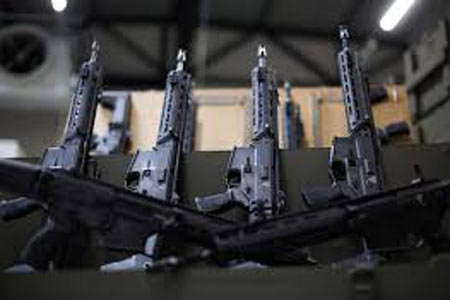- +91-8624883983
- info@insightsmicro.com
Infantry Weapons And Equipment : Trending Facts & Insights

The organization of the "Infantry Weapons and Equipment Markets" is a significant aspect of the defense market—a whole variety of guns, body armor, and gear that are distributed to different services of armies across the globe. The increasing political instability, upgrades in defense equipment, and resulting escalation in military budgets by countries are some of the key factors that are contributing to the growth of this market. With the inclusion of artificial intelligence in weapons, light body armors, and improved fighting rifles for close quarters combat, the industry advances with the current trends in warfare.
In 2023, the size of the global infantry weapons and equipment market stood at approximately USD 20 billion. The market is projected to expand at a compound annual growth rate of 4.5% in the period from 2024 to the year 2032. This rise in demand is mainly attributed to the escalation in military expenditures, wars or conflicts, and the need for precision weapons and surveillance systems, among other factors.
Global Infantry Weapons and Equipment Industry
Overview
The organization of the "Infantry Weapons and Equipment Markets" is a significant aspect of the defense market—a whole variety of guns, body armor, and gear that are distributed to different services of armies across the globe. The increasing political instability, upgrades in defense equipment, and resulting escalation in military budgets by countries are some of the key factors that are contributing to the growth of this market. With the inclusion of artificial intelligence in weapons, light body armors, and improved fighting rifles for close quarters combat, the industry advances with the current trends in warfare.
In 2023, the size of the global infantry weapons and equipment market stood at approximately USD 20 billion. The market is projected to expand at a compound annual growth rate of 4.5% in the period from 2024 to the year 2032. This rise in demand is mainly attributed to the escalation in military expenditures, wars or conflicts, and the need for precision weapons and surveillance systems, among other factors.

Types & Definition
The term Infantry Weapons and Equipment Industry refers to an industry that deals with the manufacturing, innovation, and supply of weapons, ammunition, body armor, and tactical tools that are literally made for soldiers on the battleground. This industry encompasses a variety of weapons, explosives, observation devices, and accessories for combat and peacekeeping activities, all designed to support military operations.
1. Handguns & Portable Arms: Subcategories that include rifles, machine guns, pistols, and submachine guns.
2. Use of Explosives & Bombs: Capital Equipment Used: Grenades, landmines, anti-tank, and guided bombs.
3. Specialist Protective Measures: Included are body armor, helmets, and ballistic shields in the Personal Protective Equipment.
4. Additions to Hazardous Environment The new additions include Personal Protection Equipment Specialist Equipment, which involves communication devices, night scopes, and navigation systems.
5. Robotic Weapons: Unmanned Systems Prevalent in Defense Forces Military drones and robotic combat vehicles.
6. Bunkers and any equivalents other support equipment that enables active and preventive force maintenance.
Industry Trends
The Modernization and the Build-Up of Armed Forces: To meet these contemporary challenges, nations are upgrading their armaments.
Geopolitical Conflicts are on the Upswing: The rising aggression at the borders and other near regions intensifies the market.
Joint Ventures and MCC Takeovers Continue: There are companies with defense capability in them that seek to grow horizontally or vertically.
Focus on soldier lethality programs. The goal is to enhance the performance of individual soldiers by equipping them with more advanced weapons and equipment.
Rapid Adoption of UGVs: UGVs already exist to give support to fighting arms but are preformed operations.
Facts & Insights
Intrusion of AI in Infantry Weapons: The emergence of lethal autonomous weapons/AWS and target acquisition technologies is revolutionizing the infantry of today.
Light-Weighted Material: The combination of Kevlar fibers and nanotechnology has enabled the development of very strong, lightweight body armors.
Growth of Demand for Advanced Weapons: The use of advanced weapons is increasing in an effort to improve the accuracy and efficiency of combat operations.
Global Increase in Military Expenditure. Led by the US, China, and Russia in their arms spending, some industry participants, especially those involved in the production of arms-bearing equipment, have expanded their activities.
The increase in 3D-printed weapons allows for a reduction in production costs and the creation of more munitions tailored to individual needs.
Market Segment
The types, purposes, and regions covered within the infantry weapons and equipment markets are as follows:
1. Based on the Types of Weapons: small arms, explosives, and other crude weapons.
2. Based on equipment type: safety, tactical gear, and reinforcement equipment.
3. Based on the User: Army, navy, air force, special forces, and police department.
4. By Available Geographical Regions: North America, Europe, Asia Pacific, Latin America, and Middle East and Africa.
Industry Leader
Major players operating in the market of infantry weapons and equipment are:
Lockheed Martin: A firm that deals in technological management and progressive advanced systems.
BAE Systems: Engaged in the production of military vehicles and equipment.
Northrop Grumman: Engaged in the application of innovative solutions to defense and information systems.
Raytheon Technologies: Leading the Way in the Anti-Armor Defense and Smart Weapons.
FN Herstal and Heckler & Koch, two small arms manufacturers, are dominating the Farining Narine & Koch market.